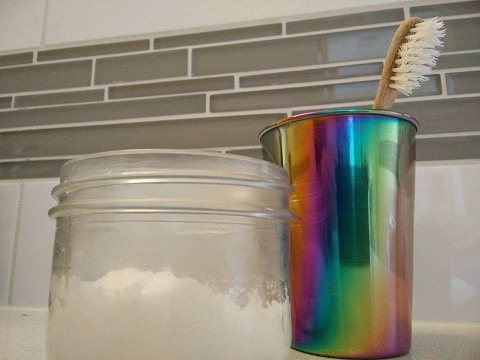How to make toothpaste

Make your own toothpaste and avoid plastic microbeads, SLS, and triclosan. (Credit: Lindsay Coulter)
What does acting like we are nature (because we are) and acknowledging that our choices affect the planet look like?
It looks like making your own toothpaste -- a significant choice! Because in taking this small, personal step you will also:
Avoid plastic microbeads which may contain toxic substances such as phthalates and bisphenol-A (BPA) that latch on, can leach into water AND are being eaten by fish and birds.
Avoid triclosan (an anti-bacterial agent) which may interfere with hormone function, contribute to antibiotic-resistant bacteria AND harm fish and other wildlife.
Avoid sodium laureth sulfate (SLS or SLES), which makes the bubbles in many store-bought toothpastes but also can be contaminated with 1,4-dioxane, which may cause cancer.
Avoid the next cosmetic scandal -- like microbeads or cancer-causing baby powder.
Save money (dirty-dozen-free toothpaste is usually about $7 a tube).
Queen of Green toothpaste recipe
Time needed: five minutes
Shelf life: approximately six months
45 ml (3 Tbsp) coconut oil
45 ml (3 Tbsp) baking soda
5 drops essential oil (optional) e.g., peppermint
2.5 ml (½ tsp) xylitol, stevia or bentonite clay (optional)
Add all ingredients to an air-tight container and mix to form a paste. You may want to melt the coconut oil first for easier mixing. Make this recipe your own by altering ingredient ratios and optional additives to get your desired consistency, flavour and results. (You can also make mouthwash.)
Note: Xylitol is a sweetener but also promotes the growth of tooth-protecting, non-acidic bacteria. Bentonite clay is helpful because it's alkaline and can assist with remineralization.
Don't care to DIY? Shop smarter by avoiding the Dirty Dozen in ALL personal care products!
What should you do with microbead products?
To see if a product contains microbeads, check the ingredient list for polyethylene (PE) or polypropylene (PP), polyethylene terephthalate (PET), polymethyl methacrylate (PMMA) or nylon. For disposal:
1. Return it to the store;
2. Mail it back to the manufacturer;
3. Donate the product to science; or
4. Filter the microbeads out and send the product to the landfill.
Do you have a secret ingredient that you add to your favourite homemade toothpaste?
Sincerely,
Lindsay Coulter, a fellow Queen of Green
Hey! Want more DSF? Join David Suzuki on Facebook

David Suzuki's Blog
- David Suzuki's profile
- 248 followers



